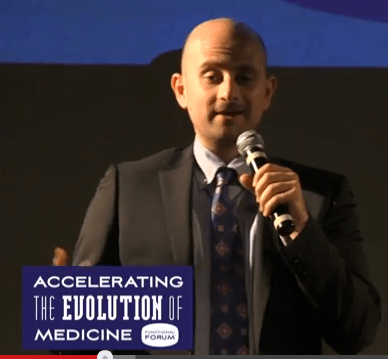Everyone knows nutritional and lifestyle changes are the keys to preventing or attenuating chronic diseases. Everyone also knows that real change is hard to achieve.
Facilitating lifestyle change can be one of the most frustrating aspects of clinical practice—or the most rewarding. It all depends on how you approach it, says Gabriel Hoffman, a Brooklyn-based nutritionist and biofeedback counselor.
On the patient side, there may be deep resistance, momentum of habit, hidden fears, and self-defeating inner dialog. On a practitioner’s side,  there are often hidden judgments. Both may share unrealistic expectations.
there are often hidden judgments. Both may share unrealistic expectations.
Speaking at the inaugural Functional Forum, Hoffman offered three simple steps he finds extremely valuable in helping clients make changes:
- Handwriting Helps:When talking to patients, encourage them to take notes by hand. It engages them in their own care. They listen better. They’re active and more involved. “The brain is coordinating all these movements to write something down. It leads to better memory.”
- Choose One Thing: Ask your patient for one thing they know they need to do that they’re not doing. There may be dozens of them—to walk more, to drink less soda, to cut out desserts. Help them pick one. Whatever it is, set an achievable goal around it and make a pact to keep track of that one thing. Trying to change many things is a recipe for failure. Better to start with one simple—and attainable—new behavior.
- Evaluate & Empower: Once the goal’s been set, establish a date for a quick follow up call or visit. On that date, ask in an open-hearted way how they’re faring. If they hit the goal, offer enthusiastic congratulations. If they haven’t, help them relax & re-set. “Let them know, “It’s cool. No worries. Don’t beat yourself up. Let’s see where you got stuck and let’s try again.”
The point, says Hoffman, is not so much to attain the goal right away, but to build trust, remove fear and minimize judgment.
Once someone feels like you really care about them, that you’re on their team, and that you want the best for them, you have a much stronger basis for helping them make lasting changes.
From Savior to Team-Mate
“Trust can’t be assumed. It has to be earned,” Hoffman told the Forum. “There may be a lot of fear under the surface. People often see practitioners the way they see teachers or parents.” And if they think you’re “selling” them something, or pushing an agenda, or if they feel judged and pressured, the fragile trust can be broken.
Lifestyle change works best when people are controlling their own processes and their own protocols. A very natural sense of control comes about when two people are in agreement, working together to accomplish something. They can communicate honestly without fear. That, says Hoffman, is what a therapeutic alliance ought to be.
“It doesn’t matter what the science says, if people don’t do it then it doesn’t really help anyone. People are going to do their own thing. If you don’t acknowledge that you wont be able to move forward in this.”
Hoffman believes prevention-focused clinicians should spend less attention on specific clinical interventions, and more on creating relationships that empower people to make their own steps toward health. Interventions based on a dynamic of patient helplessness and disempowerment tend usually fail in the long run.
The practitioner’s inner attitude needs to shift from being a “savior” to being a coach and trusted guide.
“It’s tiring trying to be a savior! Teamwork is much healthier for all of us.”
END







